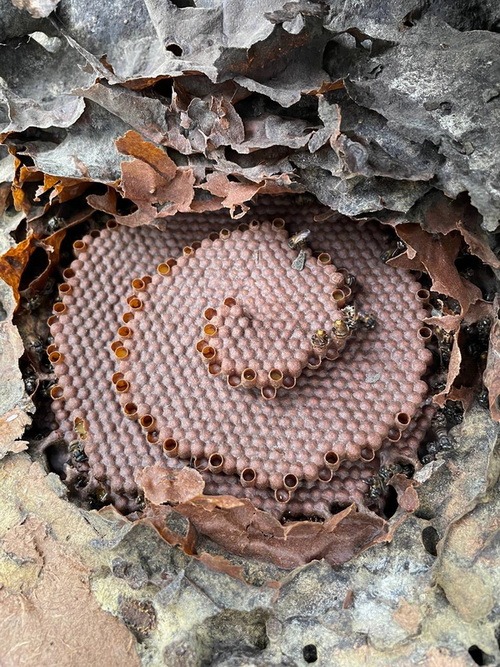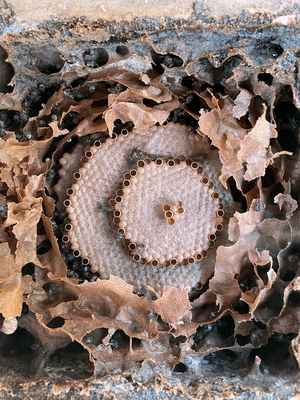Stingless bee follows existing construction plan
Workers of the stingless bee Scaptotrigona depilis build their nests according to the architectural style they perceive, Viviana di Pietro and colleagues show. And so, a tradition is born.
The brood cell complex in nests of the stingless bee Scaptotrigona depilis, which lives in South America, can have two distinct forms. In most colonies, workers build combs (plates with brood cells) horizontally one above the other, each comb starting from a central pillar: the parallel form. But in some colonies, they construct a continuous spiral comb without a central pillar: the corkscrew form. So, the workers that build the combs follow one of two possible architectural styles.
This is not a matter of hereditary makeup, Viviana di Pietro and colleagues write, nor is it an adaptation to the location of the nest or to the environmental temperature. The workers simply continue to build in the style that has already been applied, continuing a tradition.
Like honeybees, stingless bees are highly social species with queens that reproduce and workers that do the other tasks. These tasks include construction and maintenance of the nest, which they make in cavities. Workers of Scaptotrigona depilis construct combs from a mixture of wax and plant resin. They build them from the bottom up, and as said in one of two ways. They put food in each cell and close it after the queen has added an egg. The egg develops into a larva and pupa, and finally a young bee emerges.
Switching
Combs are much more often built in the parallel form than in the corkscrew form: about 95 per cent of the colonies have the parallel form.
Sometimes a colony switches from one type to another. On average, the parallel form lasts for almost two years. The corkscrew shape is maintained for a month and a half; that is much shorter, but still longer than a cohort of workers is building, namely two to three weeks. Both architectural styles are passed on from generation to generation for some period.
The researchers wanted to determine whether this is because workers are guided by the structure that already exists. They therefore conducted experiments in which they took experienced workers from one colony and placed them in another colony, the brood cell complex of which had either the familiar or the alternative form. The result was clear: workers that were placed with the type they were not familiar with, immediately continued that construction plan, instead of adhering to the building plan they were used to. Apparently, they didn’t have to learn that different architectural style from their new nest mates.
Default
In a second experiment, the researchers changed the parallel form of the combs to the corkscrew form in a number of colonies by making a cut in the top comb from the edge to the centre and placing one end on top of the other. In most cases, the workers continued to build following the corkscrew form.
The conclusion is that not much is needed to maintain a tradition. It is sufficient if the animals are guided by what exists, in this case: they apply the building plan of the existing structure. It requires no understanding, planning or communication. The technical term for this form of self-organization is stigmergy.
Probably, the parallel form of the brood cell complex is default. The researchers think that sometimes a corkscrew shape arises by error. Instead of breaking things down, the bees than continue to build according to that model.
Willy van Strien
Photos:
Large: Rare corkscrew shape comb; open cells at the margin still have to be filled
Small: Parallel combs with central pillar, the dominant form
©Viviana di Pietro
Source:
Di Pietro, V., C. Menezes, M.G. de Britto Frediani, D.J. Pereira, M. Fajgenblat, H. Mendes Ferreira, T. Wenseleers & R. Caliari Oliveira, 2024. The inheritance of alternative nest architectural traditions in stingless bees. Current Biology, online 19 March. Doi: 10.1016/j.cub.2024.02.073

